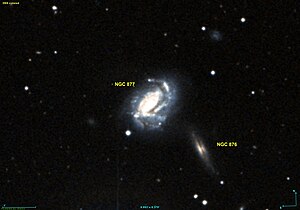NGC 877
| Galaxy NGC 877 |
|
|---|---|

|
|
| AladinLite | |
| Constellation | Aries |
|
Position equinox : J2000.0 , epoch : J2000.0 |
|
| Right ascension | 02 h 17 m 59.7 s |
| declination | + 14 ° 32 ′ 38 ″ |
| Appearance | |
| Morphological type | SAB (rs) bc / LIRG |
| Brightness (visual) | 11.8 mag |
| Brightness (B-band) | 12.6 mag |
| Angular expansion | 2.4 ′ × 1.9 ′ |
| Position angle | 140 ° |
| Surface brightness | 13.3 mag / arcmin² |
| Physical data | |
| Affiliation | LGG 53 |
| Redshift | 0.013052 +/- 0.000010 |
| Radial velocity | 3913 +/- 3 km / s |
|
Stroke distance v rad / H 0 |
(178 ± 12) · 10 6 ly (54.5 ± 3.8) Mpc |
| history | |
| discovery | William Herschel |
| Discovery date | October 14, 1784 |
| Catalog names | |
| NGC 877 • UGC 1768 • PGC 8775 • CGCG 438-52 • MCG + 02-06-58 • IRAS 02152 + 1418 • 2MASX J02175963 + 1432387 • GC 523 • H III-486 • h 216 • LDCE 158 NED003 | |
NGC 877 is a bar-spiral galaxy with an active nucleus of the Hubble type SBbc in the constellation Aries south of the ecliptic . It is estimated to be 178 million light years away from the Milky Way and has a diameter of around 125,000 ly. Together with NGC 876 , it forms a gravitationally bound galaxy pair.
The galaxies NGC 870 and NGC 871 are located in the same area of the sky .
The object was discovered on October 14, 1784 by the astronomer William Herschel using an 18.7-inch telescope .
Web links
Commons : NGC 877 - collection of images, videos, and audio files
